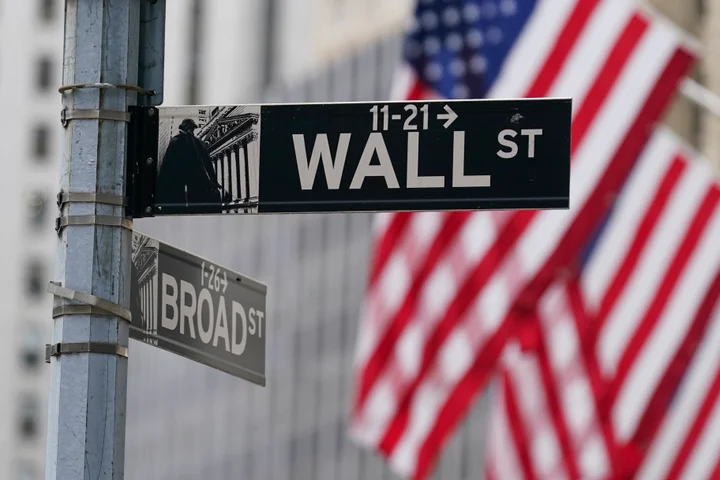NEW YORK (AP) — A powerful rally across Wall Street sent the Dow Jones Industrial Average to a record on Wednesday after the Federal Reserve indicated that the cuts to interest rates investors crave so much may be coming next year.
The Dow jumped 512 points, or 1.4%, to top 37,000 and surpass its prior peak of 36,799.65 set at the start of last year.
Other, more widely followed indexes of U.S. stocks also leaped. The S&P 500 rose 1.4% and is within 2% of its own record. The Nasdaq composite also gained 1.4%.
Wall Street loves lower interest rates because they can relax the pressure on the economy and goose prices for all kinds of investments. Markets have been rallying since October amid rising hopes that cuts may be on the way.
Rate cuts particularly help investments seen as expensive, lower quality or that force their investors to wait the longest for big growth. Some of Wednesday’s bigger winners were bitcoin, which rose nearly 4%, and the Russell 2000 index of small U.S. stocks, which jumped 3.5%.
Apple was the strongest force pushing upward on the S&P 500, rising 1.7% to its own record close. It and other Big Tech stocks have been among the biggest reasons for the S&P 500’s 22.6% rally this year.

All the excitement came as the Federal Reserve held its main interest rate steady at a range of 5.25% to 5.50%, as was widely expected. It’s hiked that rate up from virtually zero early last year in hopes of slowing the economy and hurting investment prices by exactly the right amount: enough to snuff out high inflation but not so much that it causes a painful recession.
With inflation down sharply from its peak two summers ago and the economy still solid despite high interest rates, hopes have been rising that the Fed can pull off that perfect landing. And in a press conference Wednesday, Fed Chair Jerome Powell said its main interest rate is likely already at or near its peak.
While acknowledging that inflation is still too high and the battle against it is not over, Powell said Fed officials don’t want to wait too long before cutting the federal funds rate, which is at its highest level since 2001.
“We’re aware of the risk that we would hang on too long” before cutting rates, he said. “We know that’s a risk, and we’re very focused on not making that mistake.”

That’s why Wall Street’s focus was squarely on the projections that the Fed released showing where policy makers see the federal funds rate ending 2024. They showed the median official expects it to be at roughly 4.6%.
While that implies a less steep cut than many traders on Wall Street are expecting, it’s more than the median Fed official was predicting three months ago.
Following the release of the projections, traders on Wall Street upped their bets for rate cuts in 2024. A majority of bets now expect the federal funds rate to end next year at a range of 3.75% to 4% or lower, according to data from CME Group.
Treasury yields tumbled in the bond market on such bets. The yield on the 10-year Treasury dropped to 4.01% from 4.21% late Tuesday. It was above 5% in October, at its highest level since 2007. The two-year yield, which moves more on expectations for the Fed, sank to 4.43% from 4.73%.
They both had already been down earlier in the morning, after a report showed prices at the wholesale level were just 0.9% higher in November than a year earlier. That was softer than economists expected.
Such drops in yields and rallies for stocks, though, may be threatening to undo the very future investors are banking on, according to more cautious investors.
Lower yields in the bond market make it easier for U.S. households to get a cheaper mortgage and for U.S. businesses to borrow money to expand. Rising stock prices, meanwhile, give stock-owning households more wealth. All that could put upward pressure on inflation, which could eventually force the Fed to actually hike rates again, warned Sameer Samana, senior global market strategist at Wells Fargo Investment Institute.
He also said it’s unlikely the Fed will cut rates as many times as traders are expecting in 2024 unless there’s a recession. He is expecting the U.S. economy to fall into a moderate recession early next year.
“We think it’s going to take a recession to cure that last leg of inflation” and ensure it falls all the way down to the Fed’s 2% target, Samana said.
On Wall Street, Vertex Pharmaceuticals jumped 13.2% for the biggest gain in the S&P 500 after it reported encouraging data from a study for a potential pain treatment for patients with diabetic peripheral neuropathy.
That helped offset a 6.7% loss for Pfizer, which gave a revenue forecast for 2024 that was weaker than analysts expected. Much of the shortfall was due to expectations for its COVID-19 vaccine and treatment.
Southwest Airlines lost 3.8% after it raised its forecast for how much it will spend on fuel costs during the end of 2023.
All told, the S&P 500 rose 63.39 points to 4,707.09. The Dow added 512.30 to 37,090.24, and the Nasdaq gained 200.57 to 14,733.96.
___















